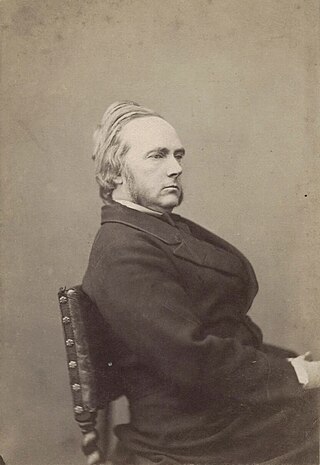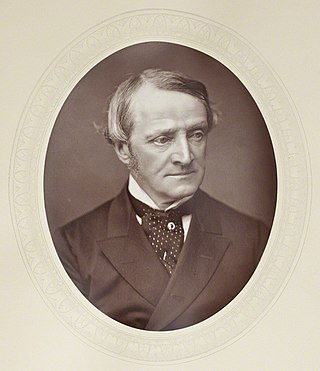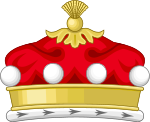
Earl of Dunraven and Mount-Earl was a title in the Peerage of Ireland. It was created on 5 February 1822 for Valentine Quin, 1st Viscount Mount-Earl. Quin had already been created a Baronet, of Adare in County Limerick, in the Baronetage of Ireland, in 1781, Baron Adare, of Adare in the County of Limerick, on 31 July 1800, and Viscount Mount-Earl on 3 February 1816. He was made Viscount Adare in 1822 at the same time as he was given the earldom. The latter peerage titles were also in the Peerage of Ireland.

George John Douglas Campbell, 8th and 1st Duke of Argyll, was a British polymath and Liberal statesman. He made a significant geological discovery in the 1850s when his tenant found fossilized leaves embedded among basalt lava on the Island of Mull. He also helped to popularize ornithology and was one of the first to give a detailed account of the principles of bird flight in the hopes of advancing artificial aerial navigation. His literary output was extensive writing on topics varying from science and theology to economy and politics. In addition to this, he served prominently in the administrations of Lord Aberdeen, Lord Palmerston, John Russell and William Gladstone.

Chichester Samuel Parkinson-Fortescue, 2nd Baron Clermont and 1st Baron Carlingford, known as Chichester Fortescue until 1863 and as Chichester Parkinson-Fortescue between 1863 and 1874 and Lord Carlingford after 1874, was a British Liberal politician of the 19th century.
Arthur Hill may refer to:
County Limerick was a parliamentary constituency in Ireland, which returned two Members of Parliament (MPs) to the House of Commons of the Parliament of the United Kingdom from 1801 to 1885.

Edward Pleydell-Bouverie PC, FRS, styled The Honourable from 1828 to 1855, was a British Liberal politician. He was a member of Lord Palmerston's first administration as Paymaster General and Vice-President of the Board of Trade in 1855 and as President of the Poor Law Board between 1855 and 1858.
This is an incomplete list of people who have served as Lord-Lieutenant of City of Limerick.

George John Shaw Lefevre, 1st Baron Eversley was a British Liberal Party politician. In a ministerial career that spanned thirty years, he was twice First Commissioner of Works and also served as Postmaster General and President of the Local Government Board.
Baron Emly, of Tervoe in the County of Limerick, was a title in the Peerage of the United Kingdom. It was created on 12 January 1874 for the Liberal politician William Monsell. He had previously served as President of the Board of Health, Paymaster General and Postmaster General. He was succeeded by his only son from his second marriage, the second Baron. He had no surviving male issue and consequently the title became extinct on his death on 24 November 1932.

Windham Thomas Wyndham-Quin, 4th Earl of Dunraven and Mount-Earl,, styled Viscount Adare between 1850 and 1871, was an Anglo-Irish journalist, landowner, soldier, sportsman and Conservative politician.

Edwin Richard Wyndham-Quin, 3rd Earl of Dunraven and Mount-EarlKP PC was an Irish peer, Member of Parliament, and archaeologist.

Windham Henry Quin, 2nd Earl of Dunraven and Mount-Earl was an Irish Peer.
Events from the year 1812 in Ireland.
Events from the year 1871 in Ireland.
William FitzGerald (1814–1883) was an Anglican bishop, first of Cork, Cloyne and Ross and then of Killaloe and Clonfert.
Richard Dawson, 1st Earl of Dartrey KP, styled the Hon. Richard Dawson until 1827 and the Lord Cremorne from 1827 to 1866, was an Anglo-Irish Liberal, and later Liberal Unionist, politician.
The High Sheriff of Limerick was the British Crown's judicial representative in County Limerick, Ireland from the 13th century until 1922, when the office was abolished in the new Free State and replaced by the office of Limerick County Sheriff. The sheriff had judicial, electoral, ceremonial and administrative functions and executed High Court Writs. In 1908, an Order in Council made the Lord-Lieutenant the Sovereign's prime representative in a county and reduced the High Sheriff's precedence. However, the sheriff retained his responsibilities for the preservation of law and order in the county. The usual procedure for appointing the sheriff from 1660 onwards was that three persons were nominated at the beginning of each year from the county and the Lord Lieutenant then appointed his choice as High Sheriff for the remainder of the year. Often the other nominees were appointed as under-sheriffs. Sometimes a sheriff did not fulfil his entire term through death or other event and another sheriff was then appointed for the remainder of the year. The dates given hereunder are the dates of appointment. All addresses are in County Limerick unless stated otherwise.
John Robert Monsell was an Irish illustrator.
Monsell is a surname. Notable people with the surname include:
Matthew Potter is an Irish academic who serves as the current curator of Limerick Museum. He is a published historian with a primary focus on governmental history and is an Honorary Fellow of the Department of History of the University of Limerick.











